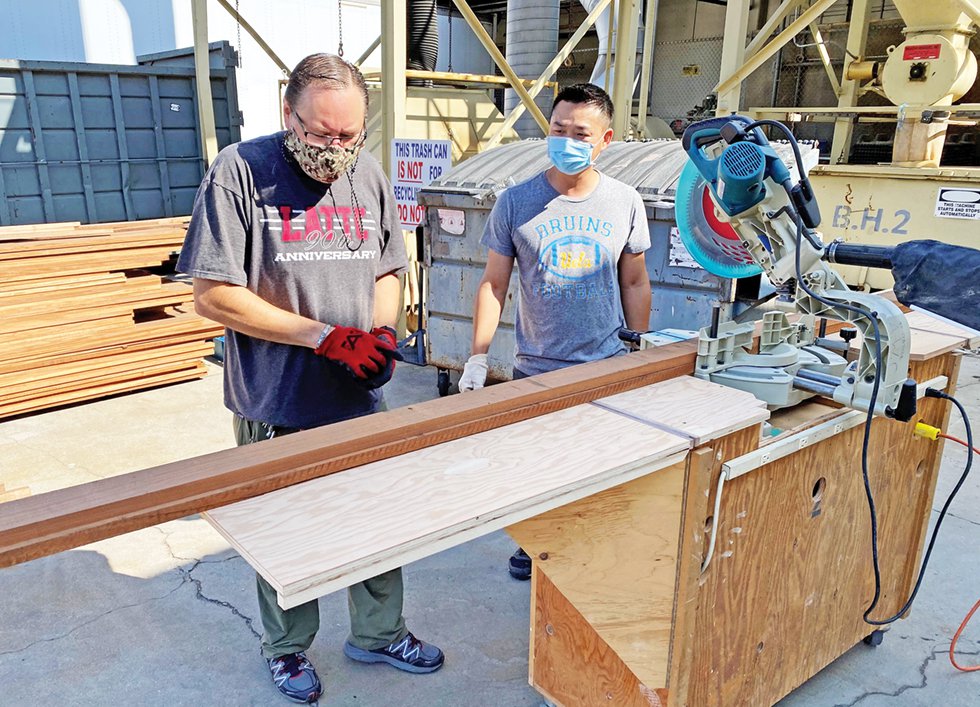
Saul Martin of Architectural Woodworking Company is pictured with MKHS Woodshop teacher Paul Lam as they work together to prepare wood pieces for student kits, which allow students to work on woodworking projects at home.
CTE educators adapt hands-on learning to a virtual world
January 18, 2021
Since the start of distance learning, many teachers have become experts at virtual teaching via Zoom. But how do you teach a virtual class when what you are teaching requires hands-on activities and industrial-level equipment?
That is one of many challenges facing the Alhambra Unified School District Career Technical Education teachers as they have had to revamp the entire structure of their classes in order to meet the needs of their students. AUSD’s CTE program is one of the largest in Los Angeles County, offering 17 CTE pathways under 11 industry sectors during the school day. Combined, the three comprehensive high schools have a team of 27 CTE teachers.
Perhaps one of the most challenging classes to transfer to a virtual realm was the wood technology courses. Prior to March, students had access to industrial-level equipment that can’t just be picked up at a local hardware store. Even if students could get their hands on similar equipment, it would come at a cost that would not make it feasible for most students.
Paul Lam at Mark Keppel High School, John Mason at San Gabriel High School and Carlos Sanchez at Alhambra High School know that students have to actually work directly with wood and tools to gain the most skills and knowledge in their classes. Together, they determined the best way to bring the instruction into the students’ homes was to provide students with individual wood kits. They worked with other woodworking teachers in the area and formed industry partnerships, which resulted in in-kind donations of wood, glue bottles and clamps totaling $40,000 for the area schools. Other industry partners (including the Society of Wood Manufacturing) provided monetary donations to provide filament for 3D printing.
In addition to securing donations to help offset the cost, the three AUSD woodworking teachers spent countless hours measuring and cutting up pieces of wood, printing parts from 3D printers and programing Computerized Numerical Control machines to cut the base of miter boxes. It was truly a collaborative partnership by these three teachers even though they teach at different schools. Mason prototyped the different furniture “to-scale” pieces the students will be making (i.e., tables, benches, planters), while Sanchez came up with the finalized dimensions for the projects and helped to cut the wood sticks. Lam 3D-printed the miter box and created the program to cut it on the CNC machine. He also used the laser cutter to create the square for all district woodworking students, and used 3D modeling software to incorporate the project and dimensions.
Other CTE teachers are putting together similar hands-on kits. Fashion Design teachers at Alhambra and Mark Keppel high schools are putting together sewing kits for each of their students. Meanwhile, the Culinary Arts students at all three high schools will soon experience an at-home Food Network “Chopped” TV show experience when they receive their fresh cooking kits from teachers.
“I know every teacher has had to find ways to adapt to distance learning, but I think those who teach CTE have had to be extra creative,” explains Leann Huang, Career Technical Education Specialist. “They’ve also had to plan far ahead in order to prepare and distribute these kits to their students so they have them in their hands before they can actually provide a lesson or demonstration. Each activity may only last one class period, but each one takes hours — and even days — of planning and preparation.”
Some CTE courses, like those in the Arts, Media & Entertainment; Information & Communications Technologies; or Engineering & Architecture sectors might be easier to adapt to a distance learning platform, but they bring along their own set of challenges, like the need for specific high-tech software that is not compatible with Chromebooks. Purchasing specific software and distributing hundreds of PC laptops was a necessary step before these students could begin working on their projects in these fields.
Although some students take CTE courses as electives and to learn new skills as part of a hobby or interest, many students take them in order to get hands-on experience that will lead to future career prospects. After high school graduation, many AUSD students continue with the Automotive Program at Rio Hondo College or the Woodworking program at Cerritos College. Some continue on to a community college or four-year university, and choose a major not related to their CTE coursework. But the abilities they gain in their CTE courses are able to transfer to a variety of other areas.
Each CTE program has its own unique set of challenges, but each group of teachers has been able to think outside the box to find innovative ways to teach their classes, even when they can’t be with them to provide in-person guidance and assistance.
Learn more at www.ausd.us/cte/.
Woodworking students will receive a kit like this one in order to participate in hands-on activities at home.


